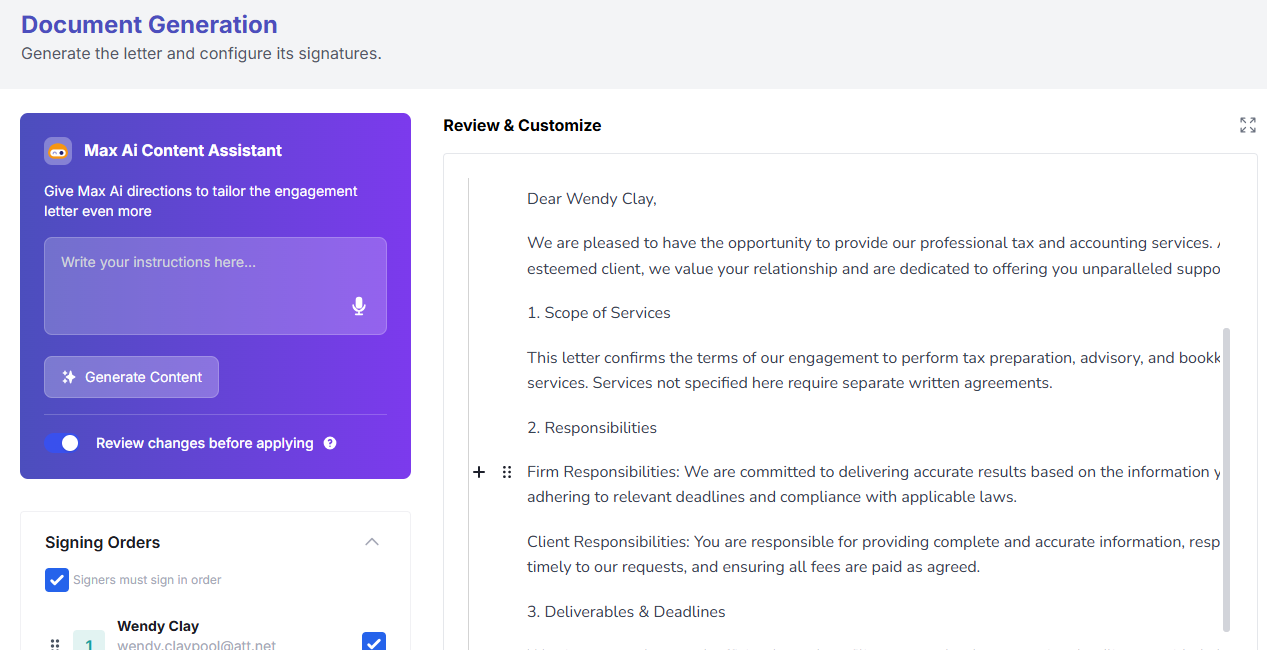
Why Engagement Letters Matter More Than Ever
Imagine finishing tax prep for a client — and suddenly they expect you to dispute an IRS notice, file payroll, or fix their QuickBooks mess… all for free.
No engagement letter? That’s how scope creep, disputes, and risk pile up.
For tax and accounting professionals, engagement letters aren’t optional:
- CPAs, EAs, and auditors are often required by professional standards to issue them.
- Insurance carriers may mandate them to minimize liability.
- All firms benefit from the clarity they bring — protecting both the client and the professional.
Put simply: if you’re serving clients in tax prep, bookkeeping, audits, or advisory services without an engagement letter, you’re putting your firm at risk.
Best Practices: What Should Be in an Engagement Letter
A strong engagement letter is more than a signature page. It’s a blueprint for the working relationship. The essentials include:
- Parties to the agreement
- Identify you (the firm) and the client (business or individual).
- Identify you (the firm) and the client (business or individual).
- Scope of services
- Define exactly what’s included: e.g., “Preparation of 2024 federal and state income tax returns.
- Clarify what’s excluded: e.g., “This engagement does not include responding to IRS inquiries unless separately agreed.”
- Define exactly what’s included: e.g., “Preparation of 2024 federal and state income tax returns.
- Responsibilities of each party
- What you’re responsible for delivering.
- What the client is responsible for (providing complete information, maintaining records, meeting deadlines).
- What you’re responsible for delivering.
- Timing and deadlines
- Filing deadlines, when client documents are due, and your expected turnaround times.
- Filing deadlines, when client documents are due, and your expected turnaround times.
- Fees and payment terms
- Pricing, retainers, billing schedules, and late payment policies.
- Pricing, retainers, billing schedules, and late payment policies.
- Confidentiality and data protection
- How client information will be handled and secured.
- How client information will be handled and secured.
- Termination and amendments
- How either party can exit or modify the agreement.
- How either party can exit or modify the agreement.
- Legal and compliance language
- Professional standards references (AICPA, IRS, state board requirements).
- Professional standards references (AICPA, IRS, state board requirements).
A well-crafted engagement letter protects your firm while giving clients confidence that they know exactly what to expect.
Protect Yourself in Writing

Enter CountingWorks PRO Engagement Letters (Powered by MAX)
The old way: dig up a Word doc, manually edit client info, export to PDF, email it, and wait. Or worse — print it, mail it, and chase signatures. If you wanted e-signature capability, you had to pay for and integrate a third-party tool like DocuSign. That process can easily take 15–30 minutes per letter. Multiply that across a busy tax season with 100+ clients, and you’re looking at 25–50 hours of unbillable admin work — gone.
The new way: MAX creates, personalizes, and delivers an engagement letter in seconds.
- E-sign built in. Clients sign securely, digitally, instantly.
- Dynamic personalization. MAX pulls context from ClientHub — services, notes, even history — and tailors the engagement letter accordingly.
- Your templates, your rules. Drag and drop existing templates (including insurance-required clauses), and MAX uses them as context.
- Conversational editing. Want to tweak language? Just ask MAX. Compare drafts side by side and send with a click.
Meet MAX: Your Ultimate AI Assistant for Tax Pros!
The ROI of Time Saved
What used to take 30 hours now takes 3. MAX turns engagement letters into effortless automation.
Let’s do the math:
- Old way: 20 minutes per engagement letter × 100 clients = 33+ hours.
- New way with MAX: Under 2 minutes per letter × 100 clients = 3 hours.
- Time saved: ~30 hours back in your pocket — every tax season.
That’s almost an entire week of work freed up, without hiring additional staff.
Connected Workflows: From Proposal to Engagement
Engagement letters are even more powerful when they’re part of a workflow:
- A signed proposal triggers an engagement letter.
- The engagement letter triggers a digital intake form.
- Onboarding tasks flow automatically from there.
One event leads to the next — no chasing, no manual admin, no dropped balls.
Watch: Build Smart, Client-Specific Intake Forms in Minutes | Tactical Tuesdays
The Real Payoff
With digital, AI-powered engagement letters, you:
- Protect yourself legally.
- Stay compliant with professional and insurance standards.
- Reduce disputes and misunderstandings.
- Save dozens of hours every year compared to the old manual process.
- Reinforce your firm’s professionalism and narrative.
Bottom line: Engagement letters aren’t busywork — they’re your safety net, your compliance guardrail, and your client relationship builder.
CountingWorks PRO engagement letters powered by MAX make them effortless, personalized, and up to 10x faster than the old way.
Read Next: Why Personalized Intake Forms Are a Game-Changer for Tax and Accounting Professionals
















.svg)